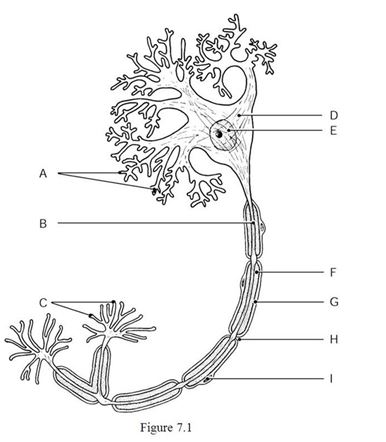A) glossopharyngeal
B) oculomotor
C) vestibulocochlear
D) vagus
Correct Answer

verified
Correct Answer
verified
Multiple Choice
 Using Figure 7.1, identify the following:
-The axon is indicated by ________.
Using Figure 7.1, identify the following:
-The axon is indicated by ________.
A) Label B
B) Label F
C) Label H
D) Label I
E) Label A
Correct Answer

verified
Correct Answer
verified
Multiple Choice
 Using Figure 7.1, identify the following:
-The gaps between Schwann cells are indicated by ________.
Using Figure 7.1, identify the following:
-The gaps between Schwann cells are indicated by ________.
A) Label D
B) Label H
C) Label B
D) Label F
E) Label A
Correct Answer

verified
Correct Answer
verified
Multiple Choice
What statement best describes the resting state of a neuron?
A) Neurons are polarized with more sodium ions outside the cell and more potassium ions inside the cell.
B) Neurons are propagating the action potential.
C) Neurons are depolarizing and generating an action potential.
D) Neurons are restoring the ionic conditions utilizing the sodium-potassium pump.
E) Neurons are repolarizing as potassium ions diffuse out of the cell.
Correct Answer

verified
Correct Answer
verified
Multiple Choice
The part of the neuron that typically conducts nerve impulses away from the cell body is the ________.
A) dendrite
B) cell body
C) synaptic cleft
D) axon
Correct Answer

verified
Correct Answer
verified
True/False
The primary motor area allows us to consciously move our skeletal muscles.
Correct Answer

verified
Correct Answer
verified
Multiple Choice
What are the major positive ions situated outside the neuron when it is polarized?
A) calcium ions
B) sodium ions
C) potassium ions
D) magnesium ions
Correct Answer

verified
Correct Answer
verified
Multiple Choice
Match the following: -Includes the pineal gland and choroid plexus of the third ventricle
A) hypothalamus
B) pituitary gland
C) epithalamus
D) medulla oblongata
E) thalamus
F) midbrain
Correct Answer

verified
Correct Answer
verified
Multiple Choice
Match the following: -Decreases digestive system activities
A) Parasympathetic nervous system
B) Sympathetic nervous system
Correct Answer

verified
Correct Answer
verified
True/False
Depolarization of neurons results from the entry of sodium ions into the cell.
Correct Answer

verified
Correct Answer
verified
Multiple Choice
What congenital disorder results when the vertebrae fail to form completely around the spinal cord, typically in the lumbosacral region?
A) cystic fibrosis
B) anencephaly
C) hydrocephaly
D) cerebral palsy
E) spina bifida
Correct Answer

verified
Correct Answer
verified
Multiple Choice
Which one of the following statements about aging is most accurate?
A) The brain reaches its maximum weight around the seventh decade of life.
B) Synaptic connections are too fixed to permit a great deal of learning after the age of 35.
C) Despite some neuronal loss, an unlimited number of neural pathways are available and ready to be developed; therefore, additional learning can occur throughout life.
D) Learning throughout the adult and aging years is supported primarily by glial proliferation.
E) Increased efficiency of the sympathetic nervous system enhances the ability to learn.
Correct Answer

verified
Correct Answer
verified
Multiple Choice
The midbrain, pons, and medulla oblongata are housed in the ________.
A) diencephalon
B) hypothalamus
C) brain stem
D) pineal gland
E) cerebellum
Correct Answer

verified
Correct Answer
verified
Multiple Choice
The large fiber tract that allows communication between the two cerebral hemispheres is called the ________.
A) corpus callosum
B) fornix
C) pons
D) thalamus
Correct Answer

verified
Correct Answer
verified
Multiple Choice
Which branch of the autonomic nervous system (ANS) mobilizes the body during extreme situations, such as rage or fear?
A) sympathetic division
B) parasympathetic division
C) somatic division
D) sensory division
Correct Answer

verified
Correct Answer
verified
Multiple Choice
Match the following: -Increases metabolic rate
A) Parasympathetic nervous system
B) Sympathetic nervous system
Correct Answer

verified
Correct Answer
verified
Multiple Choice
Match the following: -Motor homunculus and sensory homunculus
A) cerebellum
B) cerebrum
C) diencephalon
D) brain stem
Correct Answer

verified
Correct Answer
verified
Multiple Choice
What part of the neuron releases neurotransmitters from vesicles?
A) axon terminals
B) dendrites
C) axon hillock
D) Schwann cells
E) myelin sheath
Correct Answer

verified
Correct Answer
verified
True/False
Cranial nerve X is the vestibulocochlear nerve, its fibers carry sensations of hearing and equilibrium to the brain.
Correct Answer

verified
Correct Answer
verified
Multiple Choice
The vital centers for the control of visceral activities such as heart rate, breathing, blood pressure, swallowing, and vomiting are located in the ________.
A) pons
B) medulla oblongata
C) midbrain
D) cerebrum
E) hypothalamus
Correct Answer

verified
Correct Answer
verified
Showing 141 - 160 of 161
Related Exams